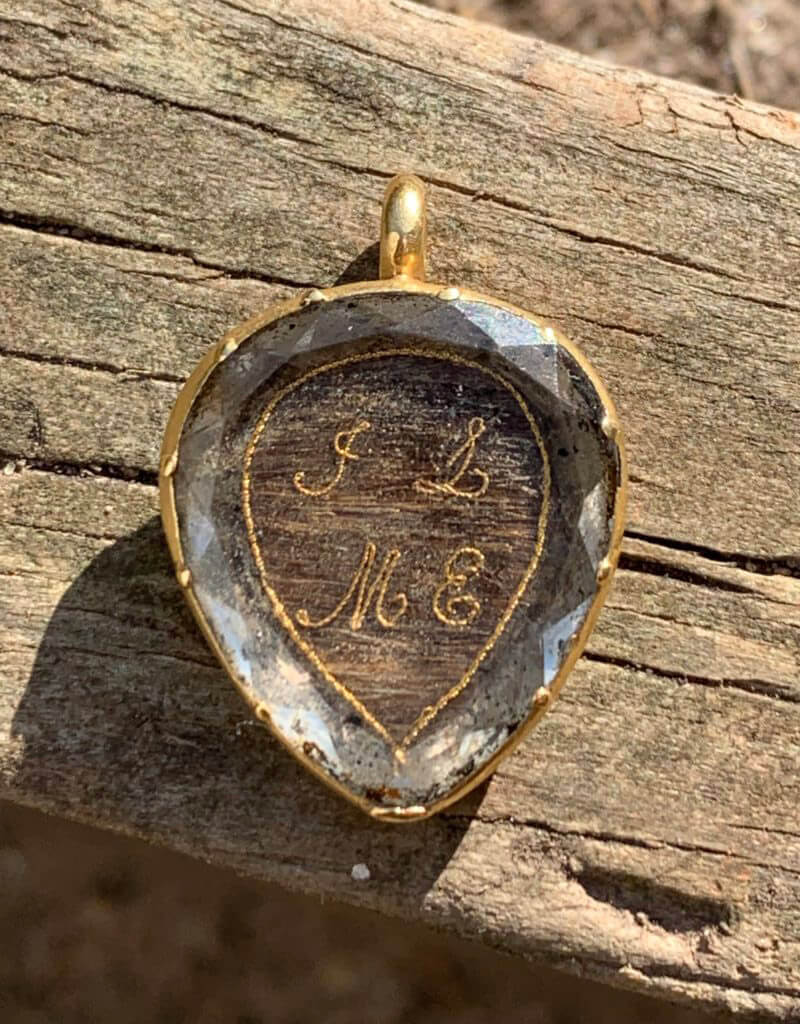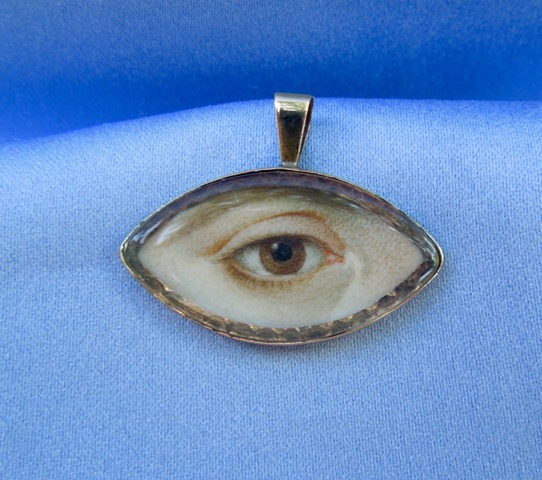Maltese Cross / Cross Formée Agate Pendant, 1830
During the 1830s and 40s, styles were defined by their large, gold floral elaborations, which were heralded in by the Gothic Revival movement at the turn of the 19th century. It took a significant shift in the mind-set of English culture to facilitate this (which I will discuss below), but the outcome was for simple messaging on smaller jewels that reflected the status/meaning of a piece. Simple messaging of ‘In Memory Of’ became the standard, often in black enamel or itched into the gold and filled by enamel, providing an element of high-relief to the jewels. Gone were the allegorical depictions of mourning and much of the pomp surrounding it; death was matter-of-fact and grand statements of love in a highly industrialised culture that was growing rapidly around the world, along with high mortality rates were all reflected in the messaging of mourning jewels.
Because of these reasons and following on from all the socio-political instability from the French Revolution to the Napoleonic Wars, mourning and sentimental jewels were becoming more formal. However, formality does not mean a lack of appreciation of style or sentiment; the cross in this post reflects this. With allegorical depictions of love being replaced with the symbolic meaning of flora and fauna, as well as the ‘magical properties’ of gems creating a new interpretation of love in jewellery, the elements of a jewel can still be interpreted to have its message. To understand this piece, we have to look to its message from the agate and what this symbol means.
The Maltese Cross (or Amalfi) is an unusual symbol. It has quite a lot of history behind it and its connections to the cross and how we see it in jewellery usage vary from the accurate appraisal to the incorrect usage as a terminology to refer to similarly styled pieces. To understand why this is so, we need to look at the Maltese Cross itself, what it represents, then look at the Gothic Revival period and then take a walk up to Golgotha with the cross itself.
For a symbol that has quite a specific title and, one would think, a specific purpose, the Maltese Cross is seen cross-culturally in everyday life. The symbol itself was first depicted (or at least, recorded) on currency c.1567, being the 2 and and 4 Tarì Copper coins. The Tarì was used in Sicily, Malta and southern parts of Italy c.913-1859 and stems from Muslim origin and manufacture, as a currency it was quite popular. It was the Grand Master of the Knights Hospitaller, Jean de la Vallette-Parisot (c.1494-1568 / Grand Master from 1557-1658) under whose leadership provided the minting of these coins, hence the relation back to the nature of the cross as a Christian symbol and also its identification as Maltese.
Characteristics of the Cross
We must now reflect upon the style of the cross and its characteristics. What is it about this cross that seems to capture the imagination enough so that it is such a popular symbol in so many of our day to day lifestyle? Firstly, note the indentations on the points of the cross and how they form an arrowhead shape with eight points. This is incredibly important to distinctively spot a Maltese Cross in our jewellery collecting, whereas many of the pieces popular in the early 19th century are based upon the Cross Formée (stemming from the subgroup of Cross pattée / St George Cross). Naturally, the cross as a motif is has its Christian basis, however, the Knights Hospitaller evolved the design, which stemmed from Crusader interpretations for other Christian warrior identifiers.
Symbolism of the Cross
Reasons for the mistaking of the Maltese Cross for its use in jewellery not only stem from its characteristics. The symbolism behind it, relating to piety, loyalty, generosity, bravery, glory/honour, contempt of death, helpfulness towards poor/sick, respect for the Church are all ideal reasons for why a piece of jewellery would be constructed and worn. In terms of symbolism, many of the pieces we have in our collections don’t have this level of detail. These are the reasons why the cross is so widely used in coats of arms around the world (namely Australia), aviation, medical services (particularly ambulance), sporting clubs and various other institutions. Bravery, loyalty, piety; all the things which construct the foundations for a respectable service or unity of like-minded individuals. Hence, this is why we see the Maltese Cross so frequently in society. It is produced and worn as an item of dress in uniforms, so it becomes more than simply a motif on a flag, it becomes physical and much of this has to do with why our jewellery collections have pieces referred to as the Maltese Cross, when this is a symbol that splintered from what much of us understand or collect.
Relation to Jewellery
The first half of the 19th century saw such a radical swing away from the culture that had preceded it since the second half of the 18th century. Christian values were starting to rebel against the seeming decadence of the Neoclassical society and art around, or at least reclaim the religious underpinnings that had dissolved when society started to merge into a more humanist view of the world. Where the symbols of death had been obvious in earlier jewellery of the 17th century and early 18th, figures of personal scenes of people in mourning were typical. The cross as a symbol of final judgement was almost anachronistic in its formal style and when used, relegated to a secondary symbol in many of these pieces. It was the person, front and centre, depicted next to an urn or tomb, weeping or looking away to watch the soul depart.
And then we have the Gothic Revival. The symbols that pushed their way back into mainstream society were not simply stark and bold as a sudden revolution back to Christian values, but they infused with the current mainstream style and blended the classic Christian motifs with the Neoclassical designs to produce pieces like the above. And what do we have there? You might think that it is the Maltese Cross, but it is the Cross Formée (note the lack of indented points), used as a way to reclaim the same ideological identifier as the Crusaders who developed this style of cross themselves. The Gothic Revival was capitalising on literally ‘reviving’ the Gothic period, its art and simplistic style. Here is a cross being re-appropriated for its time. A cross that was developed between c.1144-1271 is now becoming mainstream fashion. And while it isn’t the simple grand statement of a straight cross, it has enough style and flourish to be consistent with an opulent time in art. Notice how this cross is encrusted with foiled flat topped almandine garnets with glazed locket compartments, displaying hairwork and the names ‘Marmaduke Hart Hart’, ‘Agustus Tulte’, ‘Caroline Gordon’ and ‘Ja(me)s Peard Ley’. The humanist nature of the piece is not lost in any way, it’s beautiful, decorative, displays the dedication of the people who were loved and still has all the Christian symbolism that one would expect from a pious household. So, just because the Gothic Revival meant a swing back to Christian ideas, it didn’t dissolve what had come before.
This was a style that persisted into the 1840s, which was followed heavily by the return to the stolid cross itself. As you can see from the piece above, it’s a prime example of an agate Gothic Revival cross in memorial jewellery, with the heavy gold-world reminiscent of the Rococo style and dedication of hairwork and name. But pieces like this are still sold today under the impression of a Maltese Cross, when that has its dedicated eight points.
Here is where we need to consider one again the symbols at play. The Maltese Cross has its aforementioned symbolism, but here we have a stylised cross and it is a symbol that, as it became more and more adapted into the lexicon of an official cross for countries and institutions, there wasn’t the demand for its seemingly established symbolism to represent the self. However, regular crucifixes worked in the same capacity as one would expect from this style, so why not simply use a crucifix in the latter 19th century?
So, who is to blame for all of this mess? Well, I’m going to blame the Crusaders, just because I can. Otherwise, it’s simply a matter of interpretation!
‘Oh Hayden,’ I hear you say, ‘the Maltese Cross was still produced as a decorative item in the 19th century!’ Well, that’s true.
The Maltese Cross could be found as a charm or as a pendant on a fob chain. Much of this denotes the connection of the wearer to the institution, be it ambulance, police, relation to Malta or the Knights Hospitaller themselves. So, it has never left the cultural lexicon as an item of jewellery for as long as these institutions survive or for as long as its symbolism of strength, loyalty and piety remain.








